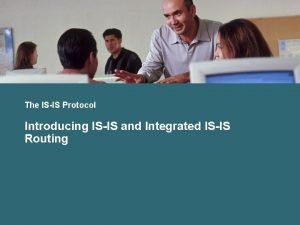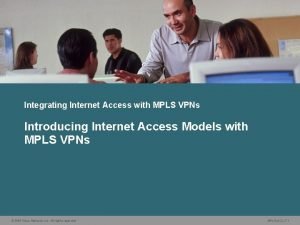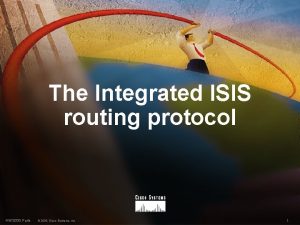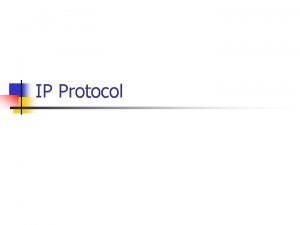The ISIS Protocol Introducing ISIS and Integrated ISIS

















- Slides: 17

The IS-IS Protocol Introducing IS-IS and Integrated IS-IS Routing

Uses for IS-IS Routing Large ISPs • Stable protocol • Originally deployed by ISPs because U. S. government mandated Internet support of OSI and IP

IS-IS Routing • IS = router. • IS-IS was originally designed as the IGP for the Connectionless Network Service (CLNS), part of the OSI protocol suite. • The OSI protocol suite layer 3 protocol is the Connectionless Network Protocol (CLNP). • IS-IS uses CLNS addresses to identify routers and build the LSDB.

IS-IS Features • Link-state routing protocol • Supports VLSM • Uses Dijkstra’s SPF algorithm; has fast convergence • Uses hellos to establish adjacencies and LSPs to exchange link-state information • Efficient use of bandwidth, memory, and processor • Supports two routing levels: – Level 1: Builds common topology of system IDs in local area and routes within area using lowest cost path. – Level 2: Exchanges prefix information (area addresses) between areas. Routes traffic to area using lowest-cost path.

IS-IS Link-State Operation Routers are identified as Level 1, Level 2, or Level 1 -2: • Level 1 routers use LSPs to build topology for local area. • Level 2 routers use LSPs to build topology between different areas. • Level 1 -2 routers act as border routers between Level 1 and Level 2 routing domains.

Integrated (or Dual) IS-IS Routing • Integrated IS-IS is IS-IS for multiple protocols: – For IP, CLNS, or both • Uses its own PDUs to transport IP routing information; updates not sent in IP packets • Requires CLNS addresses, even if only routing for IP

Integrated IS-IS Design Principles • IP and CLNP addresses must be planned. • Use two-level hierarchy for scalability: – Limits LSP flooding – Provides opportunity for summarization • Summarization: – Limits update traffic – Minimizes router memory and CPU usage

Issues with Integrated IS-IS • Default narrow metrics are limited to 6 -bit interface and 10 -bit path metric – In Cisco IOS Software Relase 12. 0, wide metrics allow 24 bit interface and 32 -bit path metric. • Cisco IOS software has default metric of 10 on all interfaces.

End System-to-Intermediate System • ES-IS forms adjacencies between ESs and routers (ISs). – IP end-systems do not use ES-IS. • ESs transmit ESHs to announce their presence to ISs. • ISs transmit ISHs to announce their presence to ESs. • ISs transmit IIHs to other ISs.

Four OSI Routing Levels

Similarities Between IS-IS and OSPF • Integrated IS-IS and OSPF are both open standard link-state protocols with the following similar features: – Link-state representation, aging timers, and LSDB synchronization – SPF algorithms – Update, decision, and flooding processes – VLSM support • Scalability of link-state protocols has been proven (used in ISP backbones). • They both converge quickly after changes.

Integrated IS-IS vs. OSPF: Area Design OSPF is based on a central backbone with all other areas attached to it. • In OSPF the border is inside routers (ABRs). • Each link belongs to one area.

Integrated IS-IS vs. OSPF: Area Design (Cont. ) In IS-IS the area borders lie on links • Each IS-IS router belongs to exactly one area. • IS-IS is more flexible when extending the backbone.

Advantages of Integrated IS-IS • Supports CLNP and IP • More extensible through TLV design

Advantages of OSPF • OSPF has more features, including: – Has three area types: normal, stub, and NSSA – Defaults to scaled metric (IS-IS always 10) • OSPF is supported by many vendors. • Information, examples, and experienced engineers are easier to find.

Summary • IS-IS is a popular routing protocol in the ISP industry. • IS-IS is a stable, fast-converging IGP that is positioned to route IPv 4, CLNS, or IPv 6. • All IS-IS interfaces have a default metric of 10. • ES-IS (for CLNS routing only) provides discovery between host and routers using hello packets to form adjacencies. Hosts send ESHs, while routers send ISHs. • OSI defines routing levels 0 through 3. Level 0 is between ES and IS. Levels 1 and 2 are between IS and IS to support intradomain routing. Level 3 supports interdomain routing. – Level 1 is intra-area – Level 2 is interarea. • IS-IS and OSPF are both open-standard link-state routing protocols that support VLSM, scalability, and quick convergence.

 Isis protocol
Isis protocol Introducing and naming new products and brand extensions
Introducing and naming new products and brand extensions Introducing and naming new products and brand extensions
Introducing and naming new products and brand extensions A concise introduction to linguistics answer key
A concise introduction to linguistics answer key Dialogue greeting and leave taking
Dialogue greeting and leave taking Signal phrase for quotes
Signal phrase for quotes Introducing james joyce
Introducing james joyce Quote analysis sentence starters
Quote analysis sentence starters How do you write a counterclaim
How do you write a counterclaim Unit 1 about myself
Unit 1 about myself How to introduce yourself in training session
How to introduce yourself in training session Ma
Ma Riddle poem
Riddle poem Introduction of human digestive system
Introduction of human digestive system Kfc company background
Kfc company background Opposite numbers definition
Opposite numbers definition Who isp
Who isp Embedded quotes mla examples
Embedded quotes mla examples

































